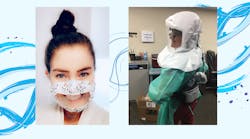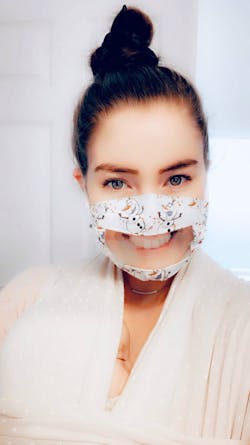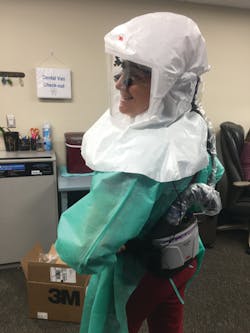It has been about a year since many of us have gone back to the office to provide dental hygiene services for our patients. We are still most likely wearing an N95 mask with a level three mask on top and a face shield or a combination of these options. Many practices have installed plexiglass barriers in the reception area, and air filters are more commonly found throughout the practice since the COVID-19 pandemic started. These engineering controls and advanced personal protective equipment (PPE) protect both patient and practitioner. While PPE is critical at this time, these added safety measures can also create barriers to communication, informed consent, and increase anxiety and fear in our patients. This is especially true for people who struggle with hearing loss or for those with intellectual or developmental disabilities (IDD). Because of these barriers, it is important to be proactive in taking additional steps to facilitate the best communication possible with our patients.
A look at history
It might be hard to believe, but when I graduated from dental hygiene school, we were not wearing masks, gloves, gowns, eye protection, or face shields. We could hold a paper chart and sit looking directly at our patients, connecting easily. We did not yet have computers, which made eye contact and communication easier all the way around. Now, most offices have computers. The majority are placed behind the patient, which makes it more difficult to review the health history and other pertinent information, while at the same time maintaining eye contact with patients.
Since the early 1980s, most of us have been wearing a mask to provide dental hygiene treatment. Before the pandemic, we were able to greet our patients without a mask, and in doing so, we could smile and help alleviate any anxiety. Patients could read our lips if necessary and hear what we were saying better, so that they could in turn make informed decisions regarding proposed treatment. Now, our patients never see us without a mask, so it is more difficult for them to hear us and see us smile to help calm their fears. When we do speak, it is more likely that our words will be muffled, quieter, and more difficult to understand even by patients with good hearing. I know this firsthand as I have lost most of the hearing in my right ear from Ménière’s disease and have trouble hearing people even when they aren’t wearing masks.
A look at the research
Research shows high-frequency sounds are reduced by 3–4 decibels (dB) when wearing a surgical mask, and by 12 dB when wearing an N95 mask.1 A 10-decibel reduction will be twice as quiet as the original decibel reading. As people age, their hearing loss generally affects these higher frequencies, resulting in greater difficulty hearing.2 Add some background noise (such as air purifiers for the room), and this decrease in decibels is enough of a reduction to affect the quality of speech for people with some level of hearing loss.1
Masks also make it impossible to read lips. They muffle sounds, and with more than half of the face covered, it is more difficult to decipher facial expressions.3 Wearing two masks and a face shield likely affects the quality of speech even more. For patients to be able to make an informed consent, understand all of their treatment options, and comply with our recommendations, the ability to hear and understand what we are attempting to communicate is of utmost importance.
Goldin et al. suggest that “...medical information, when provided, must be complete, accurate, timely, unambiguous, and understood by the patient.”1 If any of these components is missing, communication is more likely to be compromised, which raises the risk of necessary treatment not being completed or, even worse, a lawsuit.
Patients with hearing challenges
What about those with hearing challenges? Maybe these patients will not seek preventive care for fear they will miss something important. Have you ever had the experience of trying to hear what another person wearing a mask is saying while you are standing on one side of a plexiglass screen wearing your mask? Was your hearing at all compromised? Now, add in sounds of other people chatting, perhaps a radio playing, air purifiers working at maximum levels, a ringing phone,and/or another team member talking on the phone. All of these noises along with the physical barriers increase the risk that our messages are getting lost in translation. Maybe for now we will need to text while in the same room, or we may need to go back to using paper and pencil to have a discussion. Anything is possible these days, and we need to constantly think about how to improve communication so that patients are comfortable and able to make informed decisions about their oral health care.
Patients with intellectual and development disabilities
Patients with IDD are also at an increased risk of having communication issues. I have worked in a variety of settings and treated many people in the IDD population. These patients usually have an aide, caregiver, or staff member from a group accompanying them to the appointment; sometimes this person will be a family member. Newer protocols during the COVID-19 pandemic recommend that only the patient be in the treatment room. For many IDD patients, just being in a dental office can be frightening with all of the sounds and smells; for some, the fear can escalate without a caregiver nearby, increasing the possibility of behavioral issues. COVID-19 protocols may enhance this possibility, but even before the pandemic, behavioral issues for some patients with IDD still occurred. In the past, I have been bitten intentionally as well as had to cajole reluctant patients, even with their caregiver in the room.
With COVID-19 protocols, more thought will need to go into how we can communicate with the person who accompanies the IDD patient. We may need to talk with that person before or after the appointment; we may need to check in with the person who is waiting in the car or contact him/her via phone. Some IDD patients can’t talk; others can’t hear and need to communicate through sign language. How will you communicate with them? It likely takes a lot of preparation for the person who brings the patient to the appointment, so it is imperative that we be patient. We may need to reserve more time for these appointments or be prepared to only partially complete treatment that day.
Patients experiencing anxiety
Patients are feeling more stress these days due to COVID-19, lost jobs, concerns about the safety of getting nonemergency dental care, worries about family, social isolation, loss of loved ones, financial concerns, children, and the future. I think we can agree that most people do not like going to the dentist, and many feel anxious just coming to see us. When people are feeling stressed, their ability to listen takes a greater effort; this is referred to as listening effort or effortful listening, which is the ability for people to realize their innate mental resources so they can reach a goal that involves listening.4 When the quality of our speech is poor, more effort is needed to listen and hear what is being said.4 If people are not willing to do this, there is an increased risk of misunderstanding and communication errors.4
More than ever, using nonverbal communication is important and necessary when we speak with our patients, especially when we want to learn more about their needs and convey our recommendations, all while employing COVID-19 precautions. Even without a pandemic, there is evidence that when teachers use gestures and body language during a presentation, there is increased learning.5 So, even though we now have to rely less on our facial expressions, we can have some confidence in knowing that gestures and other nonverbal cues can help with communication. It is important, however, to know that not all gestures are recognized in a positive manner globally. For example, one gesture used in the US—the OK sign—is seen as insulting in Brazil, Germany, and Russia.6 If you have a patient on your schedule who is from another country, you might want to do a little research before using gestures so that you do not unintentionally insult them.
According to a literature review of six studies in the Journal of International Nursing, smiling helps to gain trust, increase comfort and compassion, create connection, and reduce barriers with hospital patients.7 Imagine how a smile can help your patients feel at ease in an environment that for many invokes stress. Depending on your patient, adding humor with a smile has been shown to decrease stress and anxiety as well.7 We use facial expressions to show empathy, among other things.5 Using facial expressions to comfort patients presents a challenge when wearing mask, so if we can smile with our eyes, it goes a long way. Our nonverbal messages can be strong, so we want to make sure we are sending the right message. If people are confused between your verbal and nonverbal messages, the nonverbal ones will win out.6
We know that there are challenges with many of the newer protocols, so what can we do? To begin with, ask your patients what might help them hear and understand more easily.3 This can be done on the phone when there are no masks, face shields, or background noises to get in the way. Although we are pressed for time even in “normal” times, it is important to slow down and take a few extra minutes for listening.8 Face your patient, make sure you have good eye contact, and speak slower and a bit louder (but don’t shout).3 Eye contact can assure patients that we are paying attention and that we care.6
Now is the time to compensate with body language. How do you hold yourself? After saying your part, ask if the patient has any questions or does not understand what you have said.3 If the patient did not understand everything, try saying it another way.3 Ask if they need clarification and rephrase your words if necessary, listen carefully, and use your voice to convey more expression than you normally would.9 Your tone makes a big difference, so be cognizant of how you speak.
Clear masks could be a great asset for nonclinical team members to try when checking patients in, reviewing proposed treatment, and discussing financial matters. This way, they can smile when a patient first arrives, helping relieve some of the tension that many are feeling more strongly these days. If a patient with hearing loss can read lips, seeing another person speak will likely increase positive communication outcomes.
Products that can help
There are only two products I know of that allow us to show our face and breathe clean air at the same time. The first one is a powered air-purifying respirator (PAPR), which uses a blower to move the contaminated air through a HEPA filter. The filter removes any contaminates and provides purified air to a facepiece. There is a constant cool breeze, which is great when we’re wearing all of the PPE, but it is loud and makes it difficult to hear what others are saying.
The other product is a new and innovative one designed by dental hygienist Cherie Le Penske. It’s a mask called Clara. Not only is the mask clear so that your patients can see your face and lips, but it also allows the provider to be able to breathe HEPA-filtered air. With its dual system, exhaled breath is also HEPA filtered. There is no fan, so it is not noisy, and there is a special port in the front that allows patients and coworkers to hear the practitioner’s voice better. Clara HEPA filters are D-100 rated, which is a higher rating than an N95 mask, but it doesn’t have the side effects N95 users experience, such as headaches and exhaustion. The Clara mask filters out 99.997% of particulates and prevents carbon dioxide buildup in the mask. The company is actively in the process of acquiring National Institute of Occupational Safety and Health (NIOSH) certification as a respirator and pursuing their US Food and Drug Administration (FDA) 510(k) class II approval. I am eager to try this mask soon.
For patients with hearing issues, the American Disabilities Act states: “Health-care providers have a duty to provide appropriate auxiliary aids and services when necessary to ensure that communication with people who are deaf or hard of hearing is as effective as communication with others. 28 C.F.R. § 36.303(c).”10 If patients are wearing hearing aids, ask if they have them in and turned on. There are apps for smartphones that can be used to amplify sound, as well as portable amplifiers. When our team returned to providing clinical care, we started wearing N95 masks with a level 3 mask on top. I noticed that I was having difficulty hearing my coworkers and patients when they spoke, and our patients experienced similar challenges as they attempted to hear us. Eventually, we started wearing a PAPR, and I no longer need to wear a mask with it. Not only can I breathe better, but I no longer have headaches and exhaustion. My patients can hear me, see my face and my smile, and some can read lips.
Adjunct help for hearing and sign language
• Video remote sign language service provides sign language for those who communicate in this way. For others who need amplification, the BeHear Now headset amplifies sound ($249).
• Jacoti ListenApp—for mild to moderate hearing loss. The patient must take a test with the hearing center or an audiologist. Wear earbuds or connect with hearing aids, and the app is free.
• Williams Sound Pocketalker: 20–40 dB acoustic gain. Comes with headphones and one earbud ($150–$200).
I don't have experience with any of these products or services, but I have used the video remote language service when I needed interpretation for non-English-speaking patients, and it works great! It’s easy and fast, and all you need is an iPad and internet service. The sign language line would also be a great resource. For more hearing help, read Mobile device apps for people with hearing loss: expanding the horizons of hearing access by Dr. Larry Medwetsky.
References
- Goldin A, Weinstein B, Shiman N. How do medical masks degrade speech reception? Hearing Review. 2020;27(5):8-9. https://www.hearingreview.com/hearing-loss/health-wellness/how-do-medical-masks-degrade-speech-reception
- What noises cause hearing loss? National Center for Environmental Health. Centers for Disease Control and Prevention. Updated October 7, 2019. https://www.cdc.gov/nceh/hearing_loss/what_noises_cause_hearing_loss.html
- Communicating effectively while wearing masks and physical distancing. American Speech-Language-Hearing Association. 2020. https://www.asha.org/public/Communicating-Effectively-While-Wearing-Masks-and-Physical-Distancing/
- Pichora-Fuller MK. How social psychological factors may modulate auditory and cognitive functioning during listening. Ear and Hearing. 2016;37(Suppl 1):92S-100S. doi:10.1097/AUD.0000000000000323
- Strain K. How much of communication is really nonverbal? Premiere Global Services. March 30, 2020. https://www.pgi.com/blog/2020/03/how-much-of-communication-is-really-nonverbal/
- Segal J, Smith M, Robinson L, Boose G. 2019. Nonverbal communication and body language. HelpGuide International. Updated October 2020. https://www.helpguide.org/articles/relationships-communication/nonverbal-communication.htm
- Colaco CAA, Pontifíce-Sousa PC, Marques R. The smile as a promoting instrument of comfort in hospitalized patients: a literature review. Int J Nurs. 2016;3(2):53-56. doi:10.15640/ijn.v3n2a7 http://ijnnet.com/journals/ijn/Vol_3_No_2_December_2016/7.pdf
- Hagstrom M. Behind the mask: 4 tips to improve patient communication Staff Care. June 10, 2020. https://www.staffcare.com/physician-blogs/behind-the-mask-4-tips-to-improve-patient-communication/
- Losing face: overcoming mask disconnect. Chicago Dental Society. May 5, 2020. https://www.cds.org/news/2020/05/05/unmasked
- Questions and answers for health care providers. National Association of the Deaf. 2020. https://www.nad.org/resources/health-care-and-mental-health-services/health-care-providers/questions-and-answers-for-health-care-providers/










